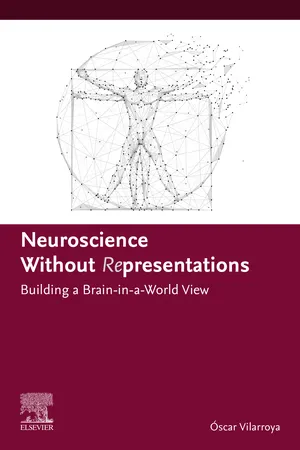
Neuroscience Without Representations
Building a Brain-in-a-World View
Óscar Vilarroya
- 300 pages
- English
- ePUB (mobile friendly)
- Only available on web
Neuroscience Without Representations
Building a Brain-in-a-World View
Óscar Vilarroya
About This Book
Neuroscience Without Representations: Building a Brain-in-a-World View describes a non-representational characterization of the brain that also provides an accounting on how humans can rely on symbolic systems and its conditions of application to deal with the representational requirements of human knowledge. Applying an evolutionary perspective to cognition, as well as assuming certain tenets from what is known as "4E cognition" (embodied, embedded, extended, and enactive cognition theories), this volume presents arguments to support a non-representational view of the brain while also outlining how non-representational brains can nevertheless be representationally knowledgeable. As both views in isolation have limitations, Dr. Vilarroya takes these ideas in a combined approach that is supported upon detailed analyses of compelling recent studies. Further, this presents a detailed guide on how to implement the alternative notion of neural representation in a research plan. Readers will gain a better understanding of the centrality of the notion of representation in neuroscientific theories and what it means for a brain to represent something, what makes a neural activity a representation, and what is represented.
- Presents original arguments to support a non-representational view of the brain and outlines how non-representational brains can also be representationally knowledgeable
- Describes the basics of an alternative to the notion of neural representation
- Details the reasons underlying the unsuitability of notion of neural representation to address the brain as a cognitive organ
- Offers detailed analyses of relevant studies from a variety of fields, including cognitive neuroscience, evolutionary biology, behavioral sciences and biological anthropology
- Provides details to help guide design, implementation and interpretation of empirical studies in this field
Frequently asked questions
Information
Table of contents
- Cover image
- Title page
- Table of Contents
- Copyright
- Preface
- Acknowledgments
- Chapter One. Some definitions
- Part I. What is the problem?
- Part II. What went wrong?
- Part III. The inside basics
- Part IV. Viewpoints to embrace
- Part V. A framework proposal
- Epilogue
- References
- Index